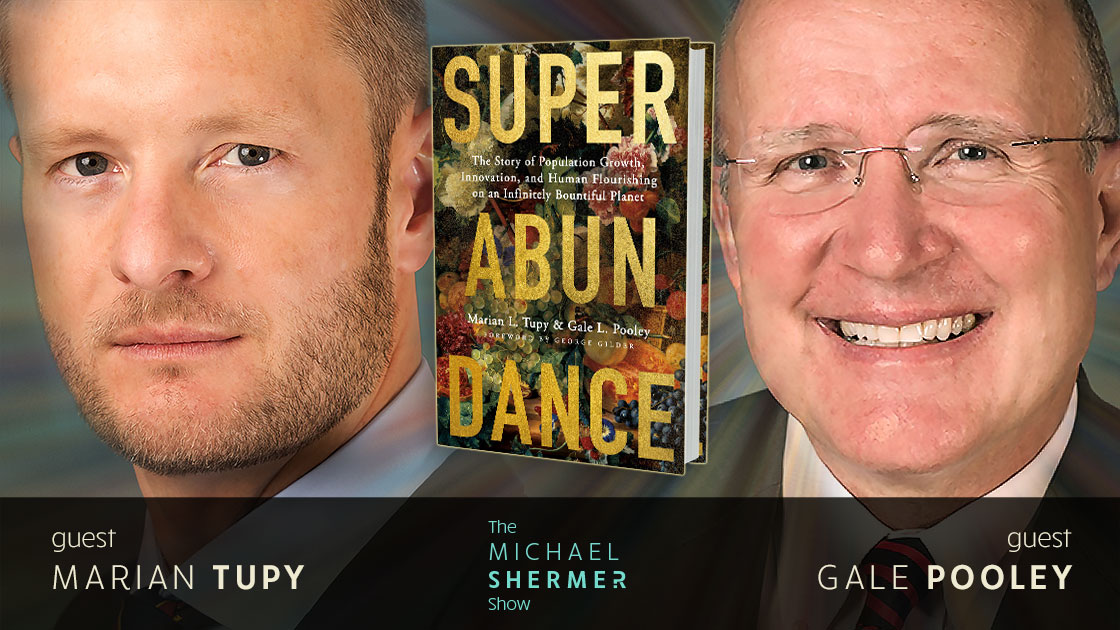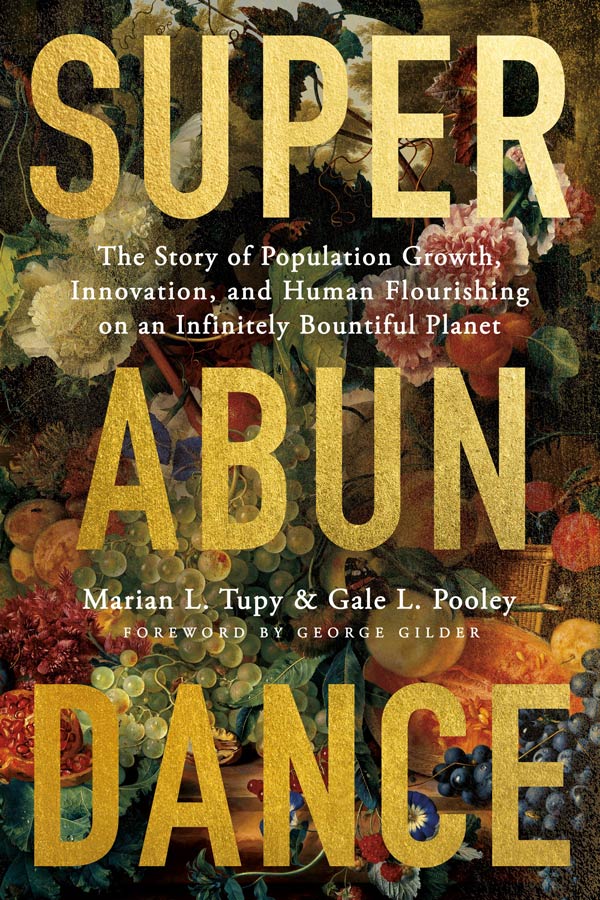Shermer, Tupy, and Pooley discuss:
- Why do we long for the “good ol’ days” and some “golden age” past?
- the Malthusian trap
- overpopulation: Paul Ehrlich’s predictions
- the Simon Abundance Index
- superabundance: when abundance grows at a faster rate than population
- compound interest and growth
- What does it mean for the economy to grow 2–3% a year?
- how wealth accumulates and what you can do to grow your own wealth
- what poorer countries need to do to become richer countries
- Will we ever run out of fossil fuels?
- Obama’s “you didn’t build that” speech (should have added “by yourself”)
- inflation and why it happens
- electric vehicles
- the birth dearth: why underpopulation could be a problem in the future
- How many people can the Earth sustain?
- post-scarcity trekonomics: the future of superabundance
- the future of religion and other social institutions in a superabundant world.
Marian Tupy is the editor of HumanProgress.org, a senior fellow at the Cato Institute’s Center for Global Liberty and Prosperity, and coauthor of the Simon Abundance Index. He specializes in globalization and global well-being and the politics and economics of Europe and Southern Africa. He is the coauthor of Ten Global Trends Every Smart Person Should Know: And Many Others You Will Find Interesting (Cato Institute, 2020). His articles have been published in the Financial Times, the Washington Post, the Los Angeles Times, the Wall Street Journal, The Atlantic, Newsweek, the UK Spectator, Foreign Policy, and various other outlets in the United States and overseas. He has appeared on BBC, CNN, CNBC, MSNBC, Fox News, Fox Business, and other channels. Tupy received his BA in international relations and classics from the University of Witwatersrand in Johannesburg, South Africa, and his PhD in international relations from the University of St. Andrews in Great Britain.
Gale Pooley is an associate professor of business management at Brigham Young University-Hawaii. He has taught economics and statistics at Alfaisal Univerity in Riyadh, Saudi Arabia; Brigham Young University-Idaho; Boise State University; and the College of Idaho. Pooley has held professional designations from the Appraisal Institute, the Royal Institution of Chartered Surveyors, and the CCIM Institute. He has published articles in National Review, HumanProgress.org, The American Spectator, the Foundation for Economic Education, the Utah Bar Journal, the Appraisal Journal, Quillette, Forbes, and RealClearMarkets. His major research activity has been the Simon Abundance Index, which he coauthored with Marian Tupy.
About the Book
Generations of people have been taught that population growth makes resources scarcer. In 2021, for example, one widely publicized report argued, “The world’s rapidly growing population is consuming the planet’s natural resources at an alarming rate … the world currently needs 1.6 Earths to satisfy the demand for natural resources … [a figure that] could rise to 2 planets by 2030.” But is that true?
After analyzing the prices of hundreds of commodities, goods, and services spanning two centuries, Marian Tupy and Gale Pooley found that resources became more abundant as the population grew. That was especially true when they looked at “time prices,” which represent the length of time that people must work to buy something.
To their surprise, the authors also found that resource abundance increased faster than the population ― a relationship that they call “superabundance.” On average, every additional human being created more value than he or she consumed. This relationship between population growth and abundance is deeply counterintuitive, yet it is true.
Why? More people produce more ideas, which lead to more inventions. People then test those inventions in the marketplace to separate the useful from the useless. At the end of that process of discovery, people are left with innovations that overcome shortages, spur economic growth, and raise standards of living.
But large populations are not enough to sustain superabundance ― just think of the poverty in China and India before their respective economic reforms. To innovate, people must be allowed to think, speak, publish, associate, and disagree. They must be allowed to save, invest, trade, and profit. In a word, they must be free.
From Dr. Shermer’s chapter on dystopias in his 2018 book Heavens on Earth
These trends set the mood to launch Paul Ehrlich’s 1968 book The Population Bomb into the bestseller stratosphere, in which the ecology biologist infamously proclaimed, “The battle to feed all of humanity is over.” As he projected: “In the 1970’s the world will undergo famines—hundreds of millions of people will starve to death in spite of any crash programs.” What to do about it? “Coercion? Perhaps, but coercion in a good cause.” He proposed a federal Bureau of Population and Environment paid for by a federal luxury tax on toys, cribs, and diapers to punish people who want to have children.
That same year the ecologist Garrett Hardin wrote in a highly influential essay on “The Tragedy of the Commons” in Science, “The freedom to breed is intolerable” because the “freedom to breed will bring ruin to all,” as if humans were no different than cattle. Therein he denounced the United Nations Universal Declaration of Human Rights’ recognition that the family is the natural and fundamental unit of society and its insistence that “any choice and decision with regard to the size of the family must irrevocably rest with the family itself, and cannot be made by anyone else.” Comparing himself to a skeptic denying the reality of witches in 17th century Salem, Massachusetts, Hardin proclaimed that “we must openly deny the validity of the Universal Declaration of Human Rights,” along with the work of Planned Parenthood, and recognize—in language more suited to a cattle breeding manual—that the “freedom to breed will bring ruin to all.” The only way to protect “other and more precious freedoms is by relinquishing the freedom to breed.”
Many environmental doomsayers followed. In 1971, the biologist and one-time Presidential candidate (on the Citizen’s Party ticket) Barry Commoner predicted in The Closing Circle that by the end of the century our “plundered” planet would run out of fossil fuels and precious minerals. “The earth is polluted neither because man is some kind of especially dirty animal nor because there are too many of us. The fault lies with human society—with the ways in which society has elected to win, distribute, and use the wealth that has been extracted by human labor.” In 1972 the Club of Rome’s report on “the Predicament of Mankind,” The Limits to Growth, predicted that economic growth would cease by the start of the 21st century. In 1974 Worldwatch Institute founder Lester Brown proved that the religious do not have a monopoly on the Apocalypse when he predicted in that farmers “can no longer keep up with rising demand,” and in 1981 that “global food insecurity is increasing,” and in 1989 that “our oldest enemy, hunger, is again at the door,” and in 1991 that the planet was like the sinking Titanic and Americans the uncomprehending passengers blind to “the scale of the ongoing degradation of the planet,” and in 1995 that “Humanity’s greatest challenge may soon be just making it to the next harvest,” and in 1997 that “Food scarcity will be the defining issue of the new era now unfolding,” and in a 2012 Scientific American article he answered in the affirmative his own rhetorical question, “Could food shortages bring down civilization?”
It’s the end of the world as we know it, and I feel fine.
Such population pessimism had its roots in the 1798 publication of Thomas Robert Malthus’s book An Essay on the Principle of Population. Therein the political economist noted that populations tend to increase geometrically (2, 4, 8, 16…) whereas food reserves grow arithmetically (2, 3, 4, 5…), leading to a catastrophic collision that historically led to famines and plagues, or what came to be known as a Malthusian collapse. “The power of population is so superior to the power of the earth to produce subsistence for man, that premature death must in some shape or other visit the human race.” In order to avert doomsday, policy makers since Malthus tended to embrace social Darwinism and eugenics and to resort to draconian measures to restrict family size, including forced sterilizations.
The results of these ideologically driven policies were calamitous. In his book The Evolution of Everything the evolutionary biologist Matt Ridley sums up the policy and its consequences succinctly: “Better to be cruel to be kind.” The belief that “those in power knew best what was good for the vulnerable and weak” led directly to legal actions based on questionable Malthusian science. The English Poor Laws implemented by Queen Elizabeth I in 1601 to provide food to the poor, for example, were severely curtailed by the Poor Law Amendment Act of 1834, based on Malthusian reasoning that helping the poor only encourages them to have more children and thereby exacerbate poverty. The British government had a similar Malthusian attitude during the Irish potato famine of the 1840s, reasoning that famine, in the words of the Assistant Secretary to the Treasury Charles Trevelyan, was an “effective mechanism for reducing surplus population.” Later in the century Francis Galton, a Darwinian by intellect and family (he was Charles Darwin’s half cousin), advocated marriage between the fittest individuals (“What nature does blindly, slowly, and ruthlessly man may do providently, quickly and kindly”), a philosophy that was embraced by a number of prominent socialists, including Sidney and Beatrice Webb, George Bernard Shaw, Havelock Ellis, and H.G. Wells, all of whom openly championed eugenics as a tool of social engineering.
As Blaise Pascal famously noted, “Man is but a reed, the most feeble thing in nature, but he is a thinking reed.” We find solutions to our problems, workarounds for our shortcomings. “Plac’d on this isthmus of a middle state,” Alexander Pope rhymed, “A being darkly wise and rudely great.” Among the darkly wise and rudely great in history who helped to lift our species above feebleness before nature’s cruelty were Jethro Tull (seed drill and horse hoe), England’s four-field rotation system, Charles Newbold (cast-iron plow, enclosure laws and grazing rights), Cyrus McCormick (reaper), John Deere (steel plow), Hiram Moore (harvester-thresher), John Froehlich (tractor), Robert Bakewell (selective breeding of livestock), the inventors of chemical fertilizers, the creators of High-Yielding Varieties of cereals, the designers of Genetically Modified Organisms (GMOs), the International Rice Research Institute and its invention of IR8 high yield rice, the creators of golden rice, and first among equals Norman Borlaug, who almost singlehandedly launched the Green Revolution and saved over a billion people from starvation, for which he received the Nobel Peace Prize in 1970. The result was the opposite of what Malthus predicted: the wealthiest nations with the greatest food security have the lowest fertility rates, while the most food insecure countries have the highest fertility rates. For example, all but one (Mexico) of the 34 nation members of the Organization for Economic Cooperation and Development (OECD) are at or below the replacement rate. On the flip side of the equation, China’s one-child policy resulted in (literally) countless abortions and female infanticide, not to mention robbing people of one of the fundament human rights recognized by all Western nations.
If you enjoy the podcast, please show your support by making a $5 or $10 monthly donation.
This episode was released on August 30, 2022.












